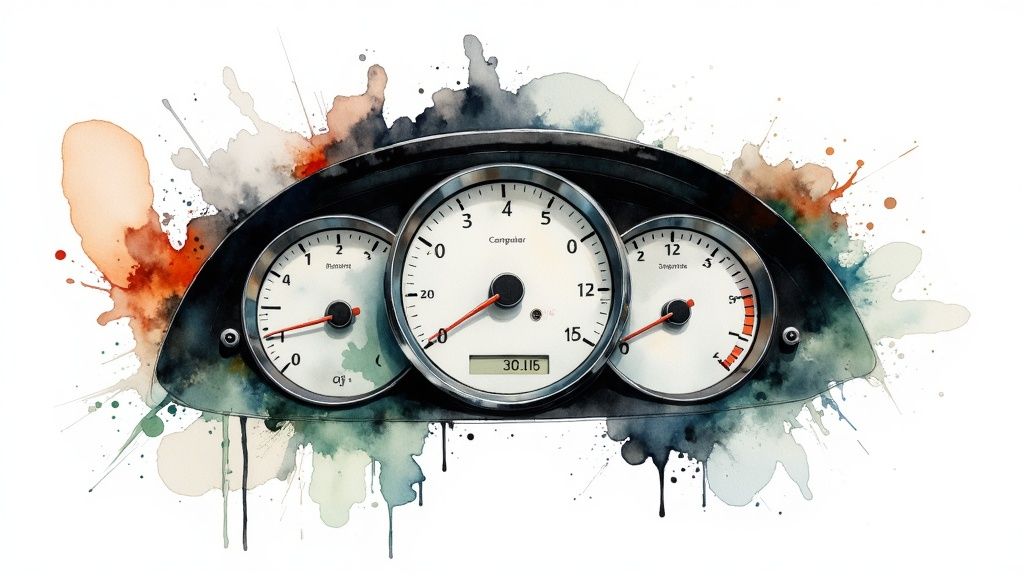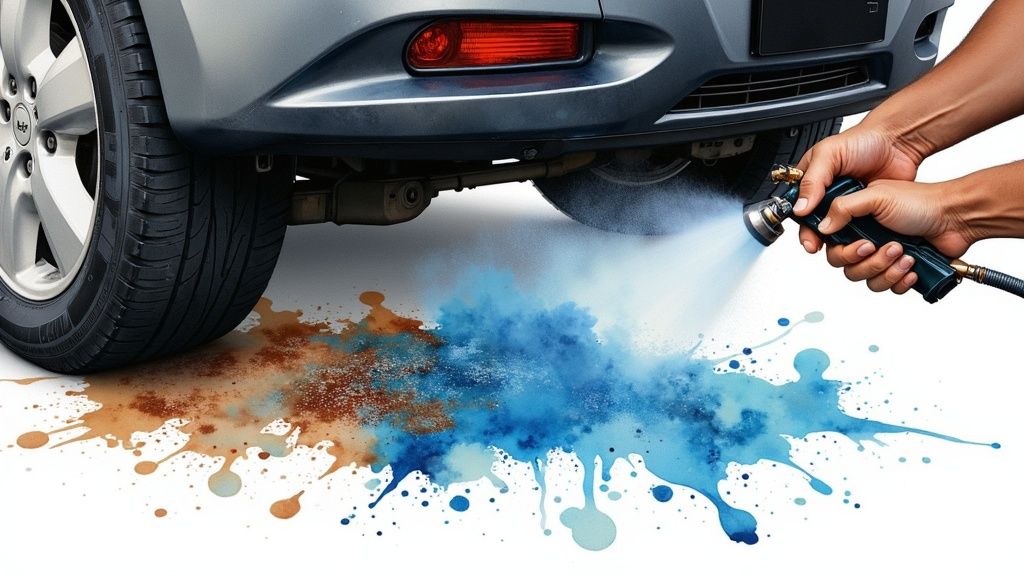
Kwik Kar Service Coupon
Get upto $20 OFF on all services.
Want your car to last longer and save on costly repairs? This listicle reveals seven key strategies to maximize your vehicle's lifespan and keep it running smoothly. Learn how to make your car last longer through regular maintenance, proper driving habits, fluid management, rust prevention, tire care, engine protection, and electrical system maintenance. These simple yet effective tips will ensure your vehicle remains reliable for years to come, whether you're a daily commuter in Richardson, manage a small business fleet, or rely on your car for essential services.
Want to know how to make your car last longer? It's simpler than you might think. Following your vehicle's recommended maintenance schedule is the cornerstone of car longevity. This strategy involves adhering to manufacturer-specified service intervals for essential tasks like oil changes, filter replacements, fluid checks, and other routine maintenance procedures. This systematic approach, based on guidelines specifically designed for your make and model, addresses both time and mileage-based maintenance requirements, covering all vehicle systems from the engine and transmission to the brakes. The manufacturer's maintenance schedule is typically found in your owner's manual.

This proactive approach offers numerous advantages. It prevents small issues from escalating into major, costly problems, which is crucial for how to make your car last longer. Regular maintenance also maintains warranty coverage on newer vehicles and optimizes vehicle performance and fuel efficiency. Furthermore, a documented service history significantly enhances resale value. For example, Toyota vehicles consistently reach 200,000+ miles, and Honda Civics and Accords regularly surpass 300,000 miles with consistent adherence to their respective maintenance schedules. This demonstrates the long-term benefits of a proactive approach.
Keeping your car in top shape requires a proactive approach to maintenance. A comprehensive checklist can help ensure you don't miss any crucial tasks. Download Your Car Maintenance Checklist Printable Today from Kwik Kar of Mesquite: car maintenance checklist printable
While the benefits are clear, there are some potential drawbacks to consider. Sticking to a regular maintenance schedule requires a consistent time and financial investment. Dealer-recommended maintenance can sometimes exceed what's strictly necessary, and it might seem unnecessary when the car appears to be running smoothly. However, these seemingly minor services are crucial for preventing long-term wear and tear and ultimately contribute to how to make your car last longer.
To make the most of your vehicle's maintenance schedule, here are a few practical tips:
Regular maintenance is essential for all drivers, particularly local Richardson commuters, families requiring safety inspections, military personnel and first responders utilizing service discounts, owners of high-mileage vehicles, and small business fleet managers. By following these tips and adhering to your vehicle's recommended maintenance schedule, you'll be well on your way to maximizing your car's lifespan and enjoying reliable performance for years to come.
One of the most effective, yet often overlooked, ways to make your car last longer is by adopting proper driving habits. How you drive has a profound impact on the longevity of your vehicle's components. This strategy involves consciously modifying your everyday driving behavior to minimize stress and wear on critical systems like the engine, transmission, brakes, and even your tires. By focusing on smooth and controlled driving, you can significantly extend the life of your car and save money on repairs and replacements down the line. This is particularly important for those seeking to make their car last longer, such as local Richardson commuters, families, military personnel, first responders, healthcare workers, owners of aging vehicles, and small business fleet managers.

This method works by reducing the strain placed on your car's mechanical parts. Aggressive driving, such as rapid acceleration and hard braking, creates excessive friction and heat, leading to premature wear. Gentle acceleration, smooth braking, and maintaining steady speeds, on the other hand, lessen the burden on these components, promoting their longevity. This also contributes to better fuel efficiency, saving you money at the pump. For example, professional fleet vehicles, often subject to rigorous driver training programs emphasizing smooth driving techniques, frequently last two to three times longer than consumer vehicles. Similarly, taxi companies that implement gentle driving protocols report a 30-40% increase in vehicle service life. These real-world examples demonstrate the significant impact proper driving habits can have on how to make your car last longer.
Here are some actionable tips to incorporate into your daily driving routine:
Pros of adopting proper driving habits:
Cons:
This approach deserves a place on this list because it is a fundamental, cost-free method that empowers every driver to take control of their vehicle's lifespan. It requires no special tools or equipment and addresses both mechanical and fuel system preservation. By incorporating these simple yet effective driving techniques, you can significantly contribute to how to make your car last longer and enjoy years of reliable service. This is particularly beneficial for our target audience in Richardson, who rely on their vehicles for daily commutes, family needs, and essential services.
One of the most crucial aspects of extending your car's lifespan revolves around proper fluid care and management. Your vehicle relies on a complex network of fluids to function smoothly. These fluids lubricate moving parts, cool the engine, clean vital systems, and protect against corrosion and wear. This strategy focuses on maintaining the correct levels of these fluids, using the manufacturer-recommended specifications, and adhering to a regular replacement schedule. This goes beyond simply changing your engine oil; it includes attention to transmission fluid, coolant, brake fluid, power steering fluid, and differential fluid (if applicable). This comprehensive approach is key to how to make your car last longer.

This comprehensive fluid maintenance strategy benefits everyone from Richardson commuters looking to maximize their car's reliability to small business fleet managers seeking to minimize downtime. For families concerned about safety, properly maintained fluids ensure optimal braking and steering performance. Military personnel, first responders, and healthcare workers will appreciate the reliability fostered by meticulous fluid care. And for owners of high-mileage or older vehicles, proper fluid management can significantly stave off costly repairs and extend the vehicle's life.
Features and Benefits: This holistic approach encompasses all vehicle fluids, emphasizing both regular changes and the quality of the fluids used. It also includes vigilance in monitoring for leaks and contamination. The benefits are substantial: preventing catastrophic failures of major components like the engine and transmission, extending the lifespan of these critical parts, and being relatively inexpensive compared to the cost of major repairs. Furthermore, checking fluid levels and even performing some fluid changes can be a DIY project, saving you money on labor costs.
Pros:
Cons:
Examples of Success: The positive impact of proper fluid management is well-documented. BMW vehicles, known for their sophisticated engineering, regularly exceed 200,000 miles without transmission issues when owners adhere to recommended transmission fluid change intervals. Similarly, heavy-duty trucks subjected to rigorous fluid maintenance programs often reach over 1,000,000 miles. These examples demonstrate the significant return on investment that fluid maintenance offers.
Actionable Tips:
Fluid care and management deserves a prominent place on this list because it's a foundational element of vehicle longevity. While it may require a bit of effort and expense upfront, it pales in comparison to the cost and inconvenience of major repairs down the road. By following these tips and prioritizing fluid maintenance, you’ll be well on your way to making your car last longer.
Rust and corrosion are silent killers, slowly eating away at your car's metal components and compromising its structural integrity. This insidious process is one of the leading causes of premature vehicle retirement, especially in harsh climates like those experienced by many Richardson commuters. Proactive rust and corrosion prevention is therefore crucial if you want to make your car last longer. This strategy combines preventative treatments with regular inspection, focusing on vulnerable areas like the underbody, wheel wells, and even minor paint chips. Addressing these areas before rust takes hold is key to preserving your vehicle’s longevity.

This approach is particularly important for those living in Richardson, Texas, where high humidity and exposure to road salt during winter months can accelerate the corrosion process. For families, military personnel, first responders, and healthcare workers who rely on their vehicles daily, preventing rust contributes significantly to vehicle safety and reliability. Small business fleet managers in Richardson can also benefit greatly from a proactive rust prevention strategy, minimizing downtime and extending the lifespan of their vehicles. This proactive approach deserves its place on this list because it addresses a major factor contributing to vehicle deterioration, ultimately helping your car last longer and saving you money in the long run.
Proactive rust prevention offers a combination of professional and DIY treatment options. Professional services like Krown, Rust Check, and Ziebart provide comprehensive underbody coatings designed to create a barrier against corrosive elements. For the DIY enthusiast, products like Fluid Film offer a more hands-on approach. This flexibility allows you to choose a method that fits your budget and comfort level. For example, vehicles treated with Krown rust protection in Canada routinely last 15-20 years in harsh winter conditions, demonstrating the effectiveness of professional treatments. Similarly, Toyota Tacomas with aftermarket underbody protection often avoid the frame rust issues common in untreated models.
Pros:
Cons:
Actionable Tips for Preventing Rust:
By taking these proactive steps, you can significantly extend the lifespan of your car and avoid costly repairs down the road. Whether you choose professional services or DIY methods, rust prevention is an essential part of making your car last longer in Richardson, Texas, and beyond.
Want to make your car last longer? Don't overlook your tires. They're the sole connection between your vehicle and the road, impacting everything from how your car handles to how much gas it guzzles. Proper tire maintenance and rotation is a crucial element in extending the life of not just your tires, but also related vehicle systems, contributing significantly to how long your car will stay on the road. This is especially important for Richardson commuters, families, military personnel, first responders, and small business fleet managers who rely on their vehicles day in and day out.
How it Works:
Tire maintenance and rotation involves a multi-pronged approach to ensure even wear and tear. This includes:
Examples of Success:
Pros:
Cons:
Actionable Tips:
Tire maintenance and rotation deserves its place on this list because it’s a fundamental, yet often overlooked, aspect of making your car last longer. For Richardson residents and others who depend on their vehicles, this preventative maintenance is essential for reliability, safety, and cost-effectiveness in the long run.
If you're serious about making your car last longer, prioritizing engine protection and care is non-negotiable. The engine is the heart of your vehicle, and its longevity directly impacts how long your car remains on the road. This goes beyond simply keeping up with basic oil changes; it requires a proactive strategy to minimize wear and tear and prevent costly repairs down the line. Proper engine care is essential for Richardson commuters, families, military personnel, first responders, and anyone looking to maximize the lifespan of their vehicle, especially owners of aging or high-mileage cars. By investing in this area, you are investing in the overall health and lifespan of your vehicle, helping you avoid expensive replacements and keeping your car running smoothly for years to come. This is crucial to how to make your car last longer.
How It Works:
Engine protection involves a multifaceted approach focused on maintaining optimal operating conditions and preventing damage from wear, contamination, and thermal stress. This encompasses everything from selecting the right fluids to adopting driving habits that promote engine health. Focusing on preventative maintenance is key to avoiding major issues that could shorten your engine’s life.
Features and Benefits:
Examples of Success:
Stories abound of vehicles achieving extraordinary mileage with diligent engine care. Mercedes-Benz diesel engines regularly exceed 500,000 miles, and Toyota V8 engines in Land Cruisers and Tundras have been known to reach 1,000,000 miles with meticulous maintenance, as documented by members of online "Million Mile Club" forums. These examples highlight the potential longevity of engines when proper care is prioritized.
Pros:
Cons:
Actionable Tips:
By diligently following these engine protection strategies, you'll significantly increase the chances of your car reaching its maximum potential lifespan and avoid costly repairs. This proactive approach ensures reliability and maximizes your return on investment, making it a crucial component of how to make your car last longer.
Want to make your car last longer? Don't overlook the electrical system! Modern vehicles rely heavily on complex electrical systems for everything from starting the engine and powering the headlights to managing fuel delivery, emissions, and safety features. Ignoring electrical maintenance can lead to expensive repairs and even leave you stranded. This is why electrical system maintenance deserves a prominent place on your car care checklist, especially if you're a Richardson commuter, a family focused on safety, or driving a high-mileage vehicle. This proactive approach will help your car last longer and perform reliably for years to come.
Modern electrical systems are far more intricate than those of older vehicles. They encompass a vast network of components, from the battery and alternator to sensors, computers, and wiring harnesses. A single fault in one area can trigger a cascade of problems, affecting multiple systems. This interconnectedness makes regular electrical system maintenance crucial for preventing costly repairs and ensuring reliable operation. This is especially important for owners of aging or high-mileage vehicles where electrical components are more prone to wear and tear.
How it Works:
Maintaining your electrical system involves several key areas:
Examples of Success:
Proactive electrical maintenance can dramatically extend the life of your vehicle. For example, Mercedes-Benz vehicles that receive regular electrical system checks are less likely to experience the costly electronic module failures common to the brand. Similarly, Toyota hybrid systems are known to routinely exceed 300,000 miles with proper electrical system care, highlighting the long-term benefits of this approach.
Pros:
Cons:
Tips for Making Your Car Last Longer through Electrical System Maintenance:
By prioritizing electrical system maintenance, you can significantly increase the lifespan and reliability of your car, saving you money and reducing the risk of unexpected breakdowns. This is especially important for those who rely on their vehicles for daily commutes, family transportation, or essential services, such as our military personnel, first responders, and healthcare workers. Investing in preventative electrical care today contributes to a more reliable and longer-lasting vehicle tomorrow.
| Strategy | Implementation Complexity 🔄 | Resource Requirements ⚡ | Expected Outcomes ⭐📊 | Ideal Use Cases 💡 | Key Advantages ⭐ |
|---|---|---|---|---|---|
| Regular Maintenance Schedule | Moderate – requires scheduled visits | Moderate – time and financial input | High – prevents major issues, maintains warranty | Vehicles needing manufacturer-specific care | Optimizes performance, maintains resale value |
| Proper Driving Habits | Low – behavior change only | Minimal – no equipment needed | Moderate – reduces wear, improves fuel efficiency | Everyday driving, cost-conscious owners | Cost-free, extends consumable lifespan |
| Fluid Care and Management | Moderate to High – technical knowledge | Moderate – fluids and occasional service costs | High – prevents catastrophic failures | Vehicles with complex transmissions or high mileage | Extends engine/transmission life, DIY possible |
| Proactive Rust and Corrosion Prevention | Moderate – inspection and treatments | Moderate to High – protective products/ services | High – preserves structural integrity and value | Vehicles in harsh/winter climates | Avoids expensive repairs, maintains aesthetics |
| Tire Maintenance and Rotation | Low to Moderate – regular checks and services | Moderate – cost of tires and services | Moderate to High – improves fuel efficiency and safety | All vehicles, especially high-mileage and safety-focused | Enhances handling, prolongs suspension life |
| Engine Protection and Care | High – specialized knowledge and products | Moderate to High – premium products and services | Very High – prevents major failures, boosts longevity | High-value or high-mileage vehicles | Protects most expensive component, reduces emissions |
| Electrical System Maintenance | High – requires diagnostics and training | Moderate to High – diagnostic tools and parts | High – prevents cascading failures and downtime | Modern vehicles with complex electronics | Preserves electronic components, ensures reliability |
Taking care of your car isn't just about keeping it shiny; it's about ensuring reliability, safety, and long-term value. From following a regular maintenance schedule and practicing proper driving habits to addressing fluid care, rust prevention, tire maintenance, engine protection, and electrical system upkeep, the insights shared in this article provide a roadmap to how to make your car last longer. Mastering these concepts translates to fewer unexpected repairs, lower overall maintenance costs, and the confidence that your vehicle will be there when you need it – whether you're commuting in Richardson, managing a family schedule, responding to an emergency, or overseeing a small business fleet. A well-maintained car is an investment that pays you back in reliability and peace of mind.
Ready to take the next step in extending your car’s lifespan? Kwik Kar Oil Change and Auto Care in Richardson, TX, is your partner in proactive vehicle maintenance. Our ASE-certified technicians offer expertise in everything from routine oil changes to comprehensive diagnostics, helping you develop a personalized plan to make your car last longer. Visit Kwik Kar Oil Change and Auto Care today to schedule an appointment and experience the Kwik Kar difference.
CLICK LINK BELOW TO LEARN MORE ABOUT OUR SERVICES

Get upto $20 OFF on all services.